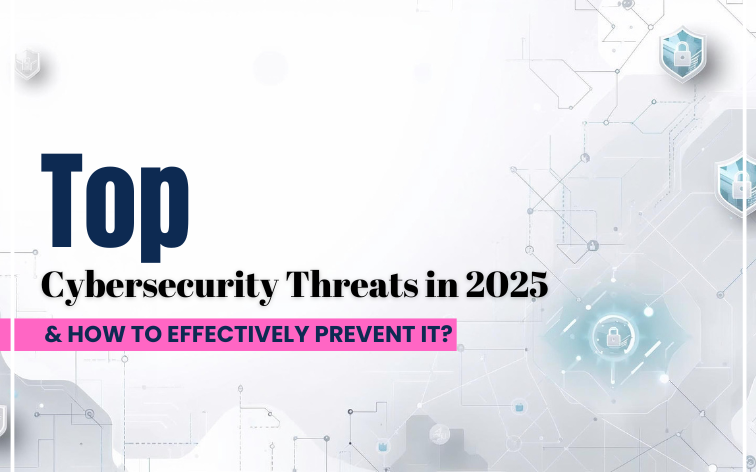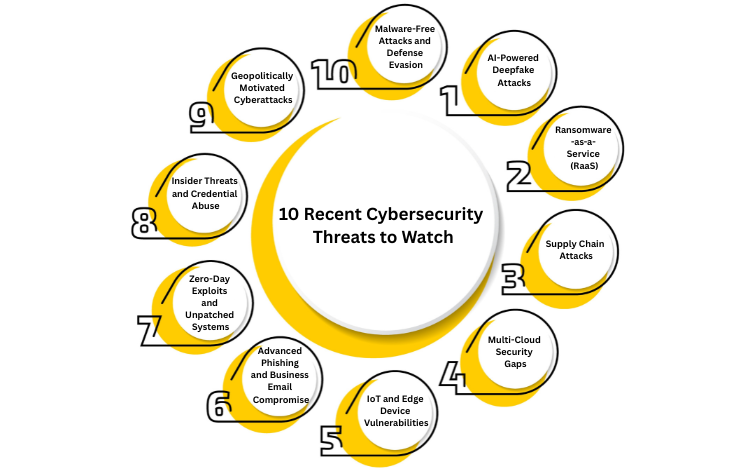
As we are moving towards the digital world increasingly, cyberattacks hiked compared to physical attacks. The crucial problem in this case is the ambiguity of the source of cyberattacks. Since technology advances, cybersecurity threats as well grow along with it. Some of the top cybersecurity threats in 2025 are AI-powered deepfake attacks, Ransomware-as-a-service (RAAS), supply chain attacks, multi-cloud security gaps, etc. To be safer in the digital community, it is important to be aware about the ever-growing cybersecurity threats and ways to handle it effectively. More students who are interested in this cyber space can study cybersecurity to bring solutions to our community. In this article, we are listing out the 10 recent cybersecurity threats, and the ways to handle it, in the long-term as well.
At Mahalakshmi Tech Campus, we are offering the bachelors programme in cybersecurity, which effectively teaches the students in and around the cybersecurity. In the contemporary society, new and innovative solutions must be brought by the aspirant techies!
10 Recent Cybersecurity Threats to Watch
Below, we listed the 10 recent cybersecurity threats to be vigilant over:
1. AI-Powered Deepfake Attacks
Deepfake technology has evolved from a novelty into a devastating weapon for cybercriminals. Using artificial intelligence to generate hyper-realistic audio, video, and images, attackers can impersonate executives, bypass biometric authentication systems, and manipulate employees into authorizing fraudulent transactions. In one notable incident, a multinational engineering firm lost $25 million when an employee was convinced by a deepfake video conference call featuring what appeared to be the company’s CFO and other executives. The attack exploited psychological vulnerabilities rather than technical flaws, making it particularly insidious. The technology’s accessibility has democratized sophisticated fraud, enabling even low-skilled attackers to execute convincing impersonation schemes that bypass traditional verification methods and erode organizational trust.
2. Ransomware-as-a-Service (RaaS)
Ransomware has industrialized into a subscription-based criminal enterprise where developers lease sophisticated attack tools to affiliates who execute the operations. This business model has lowered entry barriers, resulting in an 81% increase in attacks between 2023 and 2024. Modern ransomware variants employ double and triple extortion tactics, encrypting data, threatening to leak sensitive information publicly, and launching DDoS attacks against victims who refuse to pay. Healthcare, education, and critical infrastructure sectors have become prime targets due to their limited tolerance for downtime. Attackers exploit unpatched vulnerabilities, compromised credentials, and supply chain weaknesses to establish initial footholds.
3. Supply Chain Attacks
Third-party vendors and software providers have become the weakest links in organizational security, with attackers infiltrating trusted relationships to compromise multiple targets simultaneously. These attacks exploit the interconnected nature of modern business ecosystems, where a single vulnerability in a widely-used software component can cascade through thousands of organizations. Threat actors target managed service providers, software update mechanisms, and hardware manufacturers to inject malicious code that bypasses perimeter defenses. Nearly 60% of organizations report that concerns about third-party vulnerabilities have influenced their cybersecurity strategies. The challenge intensifies with complex multi-tier supply chains where visibility and control diminish at each level..
4. Multi-Cloud Security Gaps
Organizations migrating to multi-cloud environments face unprecedented complexity in maintaining consistent security postures across diverse platforms. Each cloud provider implements unique configurations, logging mechanisms, and policy frameworks that prevent unified visibility and control. Attackers exploit misconfigurations, identity and access management weaknesses, and the seams between different cloud environments to establish persistent access. The proliferation of shadow IT, where departments independently adopt cloud services without security oversight, further expands the attack surface. Challenges include inconsistent patching schedules, fragmented monitoring capabilities, and tools designed for single-cloud deployments that cannot adequately protect hybrid architectures.
5. IoT and Edge Device Vulnerabilities
The explosion of Internet of Things devices and edge computing infrastructure has introduced billions of poorly secured endpoints into enterprise networks. Many IoT devices ship with default credentials, infrequent security updates, and limited computational resources that prevent robust security implementations. Attackers compromise these devices to establish botnets for DDoS attacks, create lateral movement pathways into core networks, and exfiltrate sensitive data from industrial control systems. The proliferation of 5G networks accelerates IoT adoption while simultaneously expanding potential attack vectors. Medical devices, smart building systems, and industrial sensors often operate for years without security patches, accumulating vulnerabilities that become increasingly exploitable.
Learn more: What are the Three Goals of Cybersecurity?
6. Advanced Phishing and Business Email Compromise
Phishing has evolved far beyond crude impersonation attempts into sophisticated social engineering campaigns that leverage detailed reconnaissance and AI-generated content. Attackers harvest information from social media, data breaches, and public records to craft highly personalized messages that reference legitimate projects, relationships, and business contexts. Business email compromise schemes target finance departments and executives with fraudulent payment requests that appear to originate from trusted partners or senior leaders. The use of AI to generate grammatically perfect messages in multiple languages has eliminated traditional red flags. Spear-phishing campaigns increasingly exploit legitimate platforms and services to bypass email security filters.
7. Zero-Day Exploits and Unpatched Systems
Software vulnerabilities discovered and exploited before vendors can develop patches represent one of the most dangerous threat categories. Nation-state actors and sophisticated criminal groups maintain arsenals of zero-day exploits targeting popular operating systems, applications, and infrastructure components. The window between disclosure and widespread patching creates opportunities for mass exploitation, with attackers racing to compromise as many systems as possible before defenses are updated. Organizations struggle with patch management complexity, legacy systems that cannot be updated without disrupting operations, and the sheer volume of security updates requiring evaluation and testing. Critical vulnerabilities in edge devices, VPNs, and remote access solutions have enabled numerous high-profile breaches.
8. Insider Threats and Credential Abuse
Malicious insiders and compromised credentials account for a significant portion of security incidents, often causing more damage than external attacks due to legitimate access privileges. Employees, negligent users, and infiltrators working for competitors or nation-states exploit their positions to steal intellectual property, sabotage operations, or establish persistent backdoors. Credential theft through phishing, malware, or database breaches provides attackers with authentic access that bypasses perimeter defenses and appears legitimate in security logs. The shift to remote work has complicated monitoring, as traditional behavioral analytics struggle to distinguish normal activity patterns from malicious actions.
9. Geopolitically Motivated Cyberattacks
State-sponsored cyber operations have intensified as nations weaponize digital capabilities for espionage, sabotage, and influence campaigns. Critical infrastructure providers, defense contractors, and organizations in strategic industries face persistent targeting by advanced persistent threat groups backed by foreign governments. These actors employ sophisticated techniques including supply chain infiltration, zero-day exploits, and living-off-the-land tactics that use legitimate system tools to evade detection. Geopolitical tensions directly impact cybersecurity strategies, with 60% of organizations reporting that international conflicts have influenced their security planning.
10. Malware-Free Attacks and Defense Evasion
Attackers have increasingly abandoned traditional malware in favor of techniques that exploit legitimate system functions and trusted applications. These “living-off-the-land” approaches use built-in administrative tools, scripting languages, and remote management utilities to conduct malicious activities without triggering antivirus detection. Fileless malware operates entirely in memory, leaving minimal forensic evidence and complicating incident response. Attackers abuse PowerShell, Windows Management Instrumentation, and remote desktop protocols that security teams cannot simply block without disrupting legitimate operations. Detection becomes challenging as malicious activities blend with normal administrative tasks, requiring sophisticated behavioral analytics and endpoint detection capabilities.
Also read: 5 Common Cybersecurity Mistakes to Avoid
How to Handle Cybersecurity Threats?
- Deploy Advanced Threat Detection Systems: Implement AI-powered security information and event management platforms that establish behavioral baselines and scan across network, endpoint, and cloud environments to detect sophisticated attacks before they cause damage.
- Establish Zero Trust Architecture: Adopt a “never trust, always verify” security model that requires continuous authentication, enforces least-privilege access, and implements micro-segmentation.
- Regular Security Awareness Training: Educate employees through simulated phishing campaigns, interactive workshops, and role-specific training that addresses social engineering tactics, recognizes suspicious activities, and establishes clear reporting procedures.
- Strengthen Identity and Access Management: Use multi-factor authentication and regularly audit permissions to eliminate privilege creep, enforce strong password policies, and monitor authentication attempts.
- Perform Regular Security Assessments: Conduct penetration testing, vulnerability assessments, and red team exercises that simulate real-world attacks, identify weaknesses before adversaries exploit them.
- Encrypt Data Comprehensively: Implement encryption for data at rest and in transit, protect backup systems with separate credentials and offline storage.
Learn more: Guaranteed Cybersecurity tips for different types of Cyber attacks
Building Long-Term Cyber Resilience
Organizations must go beyond reactive defense to cultivate resilience that anticipates threats, adapts to evolving attack methods, and maintains operations even under attacks. Resilient organizations ensure cybersecurity through regular maturity assessments, adopt emerging technologies after security evaluation, and maintain flexibility to change the strategies to keep up with the ever-growing cybersecurity threats. Apart from the organizations, in a broad perspective, students must be encouraged to study and find unique solutions to prevent cybersecurity threats. Allocating a separate budget for this allows the students to actively participate in it and bring defensive softwares and applications for a better digital environment. From the college days itself, students must be involved in cybersecurity projects to sharpen their expertise.
Conclusion
The cybersecurity challenges of 2025 demand constant vigilance, investment, and strategic thinking from organizations across all sectors. The combination of AI-powered attacks, ransomware operations, supply chain vulnerabilities, and geopolitical tensions has created a threat environment where we should not be easy going. However, organizations that approach security holistically, combining advanced technologies with human awareness and implementing defense-in-depth strategies can successfully face these dangers. Encouraging students to develop effective solutions can also solve the problems we are encountering in the digital world.





